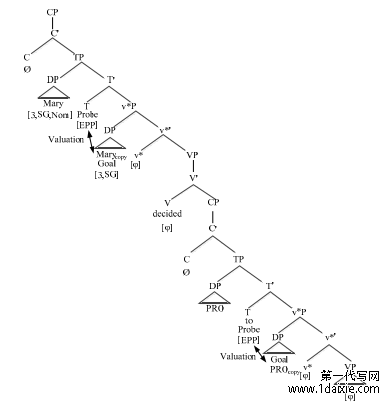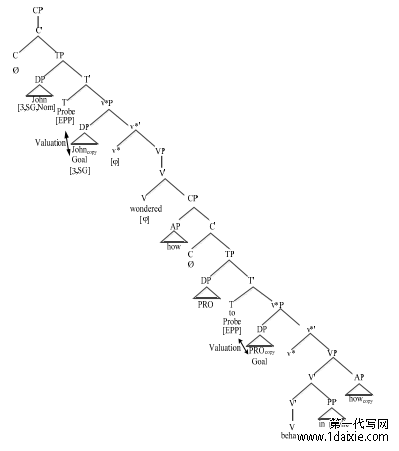本文是一篇代写英语毕业论文,本文对英语控制结构的句法派生进行了全面的研究。英语控制结构的传统派生分析主要有两种:动作分析和非动作分析。前者支持英语控制结构是由运动操作派生的,PRO是运动的NP剩余。后者将PRO引入英语控制结构的推导。但这两种方法都不能很好地解释英语控制结构的句法推导,因为运动否定了PRO的独特性质,而非运动分析主要从OC和NOC的角度进行,这两种方法存在争议。
Chapter 1 Introduction
1.1 Research background
Chomsky (1981) discusses Ccs under government and binding (hence GB) framework. He determines the nature of Ccs by comparing them with raising structures.
(2) a. Johni [ yp seems [s ti to [ yp be sad]]].
(Chomsky, 1981: 35)
b. John promised Bill [PRO to feed himself].
(Chomsky, 1981:75)
(2b) is similar to (2a), but actually they are not the same. The operation of raising is to raise the clausal subject to the matrix subject. However, we find that PRO is not a trace left behind by matrix subject raising process, for the PRO can refer to someone else. Besides, their differences can also be proved by “there” patterns and subject idiom chunks, and neither of them can be taken as the subject of PRO. Beyond that, the active and passive voices of Ccs are not identical from semantic aspects.In the syntactic domain in the period of GB, two theories are related to the Ccs in English, namely, predication theory (Williams, 1980) and thematic theory (Nishigauchi, 1984). There are two kinds of Ccs in William’s prediction theory (1980), i.e., obligatory control (OC) constructions and non-obligatory control (NOC) constructions. PRO in OC must rely on the nominal component in the sentence to confirm its reference, while NOC is a subjective control since the reference of PRO is confirmed according to the context. According to prediction theory, NP/AP/PP/VP is seen as a simple centered predicate, while PRO and WH- are as complicated predicates that embody PRO and WH- variants, and the open position of PRO and WH- located make it a predicate. The sentence component is divided into argument and adjunct according to its relation with predicate verb. Williams (1980) neglects PRO and conversely considers the whole sentence. According to Williams’ view, PRO co-indexes with VP, and the distribution of PRO is irrelevant to the control theory. The OC belongs to predicate while NOC is not
.................................
1.2 Research purposes
From above, although scholars expound the English Ccs by Minimalist hypothesis, there still remain many questions about English Ccs. With the proposal of the newest phase theory within MP framework, it poses challenges to the present studies of English Ccs. English Ccs is a matter of continuing concern due to its complexity and uncertainty. It can be inferred that the conclusions made in GB period are of descriptive, and the hypothesis of lexical properties in GB model takes semantics of specific vocabulary into consideration. It truly increases the difficulty of English Ccs research. Under the guidance of MP theories, this thesis aims at finding out the underlying syntactic derivation of English Ccs and verifying rationality of the proposed models on English Ccs.
More specifically, the three main aims of the thesis are:
ⅰ. To corroborate the unique existence of PRO in English Ccs.
ⅱ. To explore the syntactic derivation of English Ccs.
ⅲ. To find the differences in the syntactic derivation of argument and adjunct control constructions by analyzing some language facts.
............................
Chapter 2 Previous Studies of English Control Constructions
2.1 Movement analysis
GB model derives sentences in deep structure (DS), and it determines the syntactic hierarchy by thematic roles in the surface structure (SS) and then transform it to SS. But in MP framework, DS and SS are abolished, it is contended that sentences are derived by merge and move operation. Move operation allows the derivation of SOV order. GB model assumes that movement operation left behind trace. As shown in (7).
GB model applies trace t to identify some characteristics of constitutes moved. While MP model produces copies in the new position, and trace is of no use under MP. Previous sections have mentioned some types of movement, such as the NP movement in the subject raising structure, which aims at filling the specifier of TP with the subordinate DP and obtains a nominal case. Some scholars believe this method would provide reasonable explanations to the English Ccs.
2.1.1 Hornstein (1999, 2003), Boeckx & Hornstein (2004, 2006, 2007, 2010)
Hornstein (1999) argues that English Ccs should get a uniform explanation instead of a special sub-theory. He is in favor of eliminating the control module, and it is consistent with the spirit of minimalism that discards the DS and SS. On the basis, he thinks the θ-role constraints no longer exist, and a NP bears only one θ role. He treats θ-role as features of control verb and θ-role assignment as feature checking process. He analyzes OC as the result of movement, and depicts the unexpressed subject of NOC as pro. He puts forward that the removal of restrictions on θ-roles, chains, and merger reduces the burden of sentence derivation. Finally, he illustrates this view by the example below.

.............................
2.2 Non-movement analysis
Movement analysis reduces the syntactic derivation of Ccs to the result of movement, and it supports PRO-less derivation process of Ccs. While non-movement analysis approves that syntactic derivation of Ccs should involve PRO, and it maintains that both the control theory module and PRO are necessary to the research on Ccs, since it can differentiate Ccs from other configurations on the syntactic level.
The non-movement analysis takes PRO into account, and thus it involves several aspects of PRO. However, the MP model cancels DS and SS, the original assumption, which PRO lies in the DS and then transformed to the SS, and it is not applicable for contemporary period. Scholars put forward their own standpoint on the English Ccs.
2.2.1 Chomsky (1977, 1981, 1995)
Chomsky (1977, 1981) explores Ccs from GB perspective, and he describes restriction of rules, rule feature and exceptional case of Ccs. Chomsky (1977) proposes that Ccs are closely linked to complement (hence forth COMP) system, and he uses the notion “filter” (which is a device to regulate the transformations) to define the properties of Ccs, such as transformation of “for” and “to”. He observes that some words take complementizer “for” in their embedded clause, such as “want” “prefer” and other verbs (control verbs) takes null-complementizer as infinitive complement. “for” in the (20a) can be deleted, as shown in (20).
..............................
Chapter 3 Theoretical Framework ................................. 24
3.1 Background and development of MP ............................. 24
3.2 Empty categories theory ............................... 27
3.3 Control theory ............................................ 29
Chapter 4 PRO in English Control Constructions .............................................. 41
4.1 Presence of PRO in MP ...................................... 42
4.1.1 Ellipsis evidence ..................................... 42
4.1.2 Argument structure evidence .................................... 45
Chapter 5 Syntactic Derivation of Argument Control Constructions ............... 51
5.1 General properties of argument control constructions .................................... 52
5.2 Derivation of subject clauses ................................ 54
Chapter 6 Syntactic Derivation of Adjunct Control Constructions
6.1 General Properties of adjunct control constructions
The controller for PRO in adjunct Ccs may have an Agent role that the thematic relation of Agent might be different in nature from “major” thematic relations such as Theme, Goal etc. It is necessary to distinguish this type from above argument Ccs.
Chomsky (1981) supposes that PRO can locate in every position of a logical thematic subject whose antecedent is of thematic, as the example of depictive adjuncts in (67).
(67) Maryi greeted a girlj without PROi/*j knowing it.
PRO as the head of adjunct clause, Williams (1980) calls it adjunct control, thus constructions like (67) are adjunct Ccs.
Adjunct belongs to the secondary element of sentence since it does not change nature of verb. Because the adjunct does not always present x-bar independent relations, and adjuncts are always derived outside of VP or outside of the first projection of V. Thus adjuncts are independent of almost all the relevant structural relations we can recall, such as c-command, dominance etc. Phase theory illustrates that adjunct clause forms a kind of barrier to bar the structural relations.

..............................
Chapter 7 Conclusion
7.1 Major findings of the thesis
This thesis claims that PRO is the key notion of English control constructions. It suggests that presence of PRO can be proved by ellipsis evidence and existing equivalent to that of NP-trace. Presence of PRO is also supported by argument requirement. Besides, logical semantic interpretation indicates the difference between PRO and NP-trace. Thus PRO is of special syntactic status and it cannot be interpreted as NP residue of move operation. This thesis suggests that PRO possess null case, and discharge of null case is grounded on null C according to phase theory but not traditional spec-head relation since DS and SS are casted away in MP. The specific case valuation mechanism is as follows.
(79) [CP C [TP PRO [T to [DP PRO win].
Null case valuation mechanism is similar to that of structural case. Base-derived PRO first merges with verb to v*P, and then the formed v*P merges with T. PRO is attracted to the spec-T due to its EPP feature, finally TP is valued by null C, and it forms CP. T distributes null case to PRO. At last all uninterpretable features are valued and syntactic operation completes.
This thesis adopts Landau’s (2013) classification that divides English Ccs into argument Ccs and adjunct Ccs. When the clause which contains PRO acts as the subject and complement of the sentence, and it belongs to the argument type. It is attached to the adjunct type if the clause which contains PRO clause serves as adjunct of the sentence.
Inspired by the OC and NOC classification, subject clause of argument Ccs is organized into bare infinitive subject clause and gerunds subject clause. Complement clause of argument Ccs is categorized into declarative complement clause and interrogative complement clause. It is proved that the presented syntactic derivation can bypass the complicated difference of OC and NOC and provide a uniform explanation to the derivation of English Ccs.
reference(omitted)
